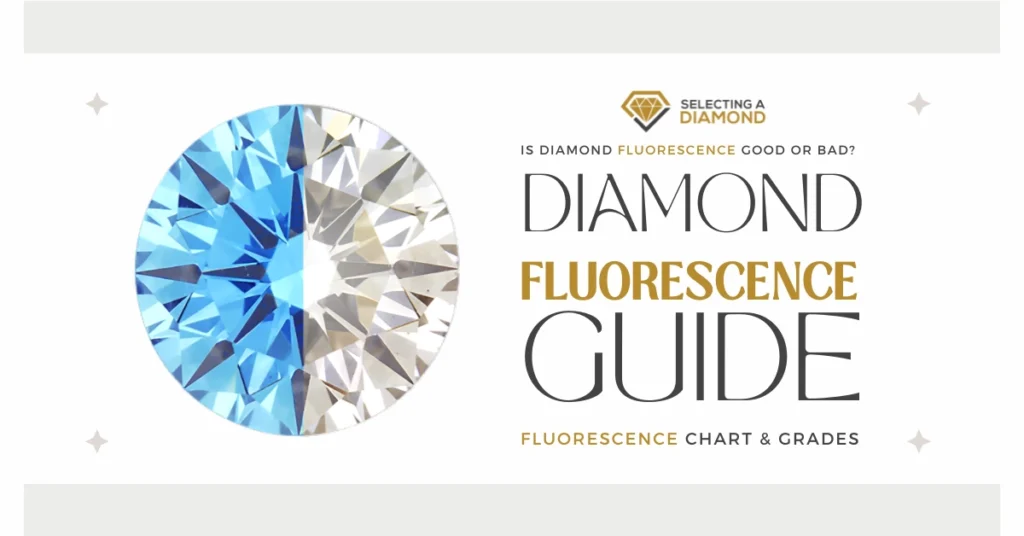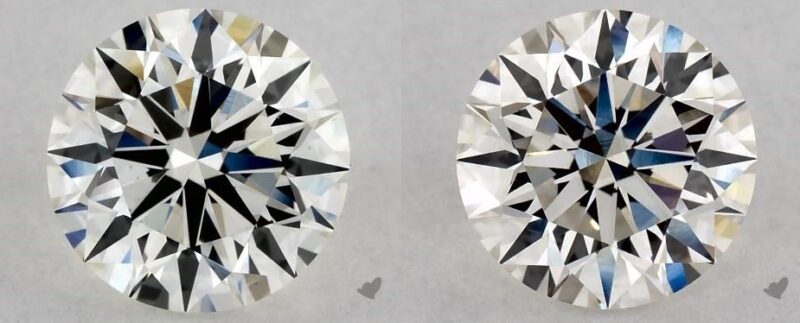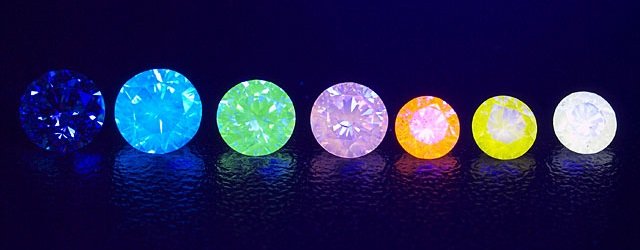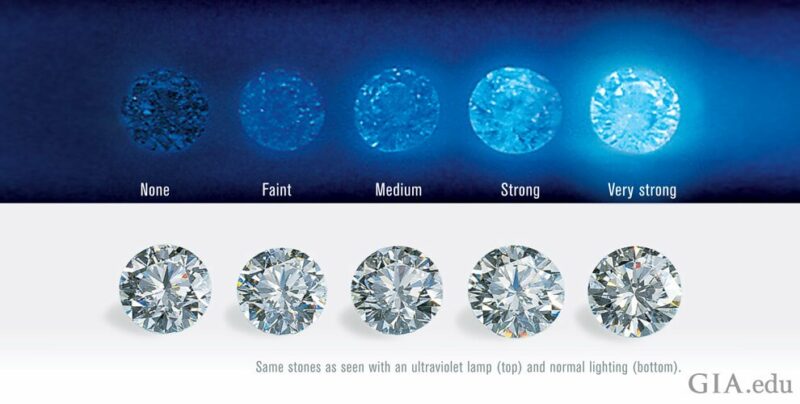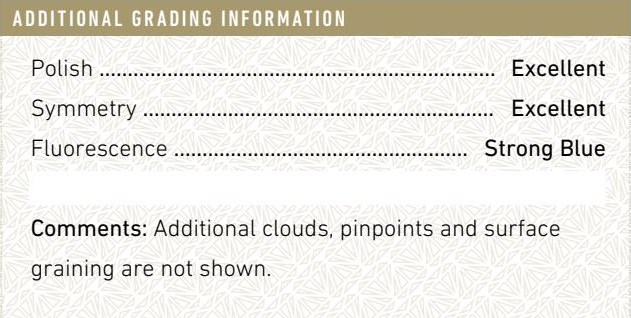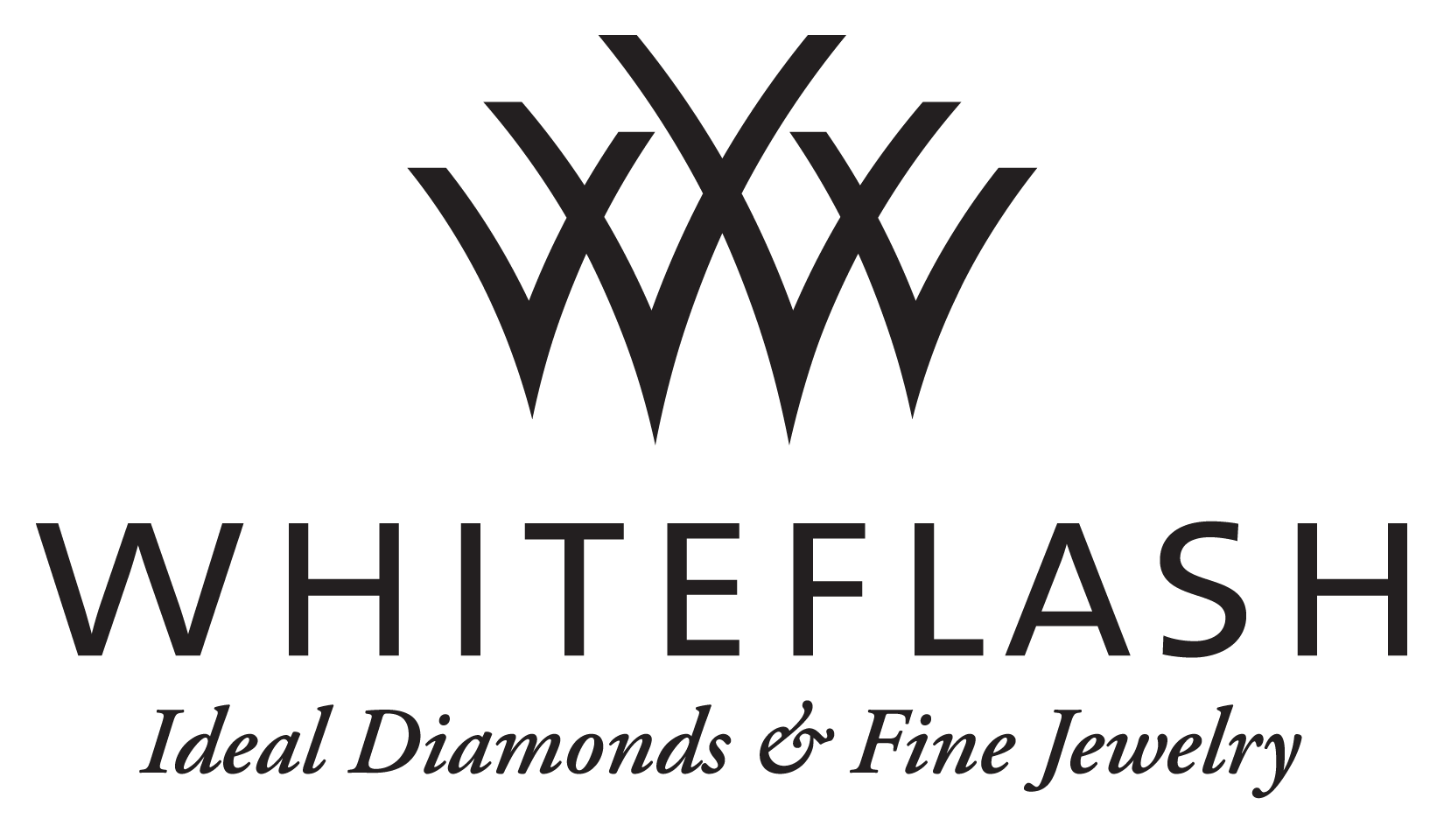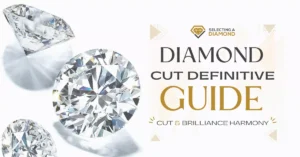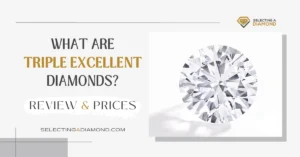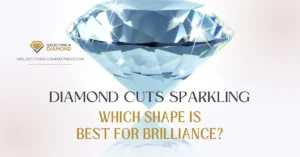We may earn a commission when you purchase through our affiliate links, at no extra cost to you. This helps support our work and allows us to continue providing unbiased, expert diamond advice.
Among all other diamond characteristics, fluorescence often stirs up the most debate, securing its place as the most contentious aspect.
This stems from the fact that it isn’t an issue of absolutes; there’s no unequivocal right or wrong. Although certain guidelines can help navigate this trait, ultimately, it boils down to individual taste.
Take, for example, this 1 carat I-VS2 diamond with an excellent cut. Now compare it with an almost identical diamond, the key difference being its faint fluorescence. Here, we have both diamonds presented side by side for your reference:
When viewed under everyday lighting conditions, as depicted in the images above, it’s virtually impossible to discern any difference. That’s precisely why understanding the concept of diamond fluorescence is crucial, and knowing when it’s perfectly fine to choose a diamond with a touch of fluorescence.
Let’s delve deeper into this fascinating subject.
What Exactly is Diamond Fluorescence?
Diamonds are not just beautiful but also incredibly complex gemstones, each exhibiting a constellation of distinct traits that contribute to their enigmatic allure.
Among these traits is an intriguing property called fluorescence, where the diamond emits light upon exposure to ultraviolet radiation. Despite being a commonplace feature, diamond fluorescence often leads to confusion and sparks debates among both gemologists and diamond buyers.
This blog post aims to demystify the concept of diamond fluorescence, detailing everything from its scientific underpinnings to its influence on a diamond’s appearance and value.
When a diamond is subjected to ultraviolet light – be it from the sun, fluorescent bulbs, strobe lights or any other UV sources – the diamond may respond by emitting this subtle colored glow, what we know as fluorescence.
What Causes Fluorescence in Diamonds?
Fluorescence in diamonds is attributed to the presence of sub-microscopic inclusions or trace amounts of elements other than carbon, which is the primary component of diamonds. Certain elements like nitrogen, boron, or aluminum, as well as certain structural anomalies in the diamond’s carbon lattice, play a role in this process.
Here’s how it works:
When a diamond is exposed to UV light, these elements absorb the energy from the light. This excites the atoms, causing them to move into a higher-energy state.
When the atoms return to their normal state, they emit the absorbed energy in the form of light, causing the diamond to glow, or fluoresce. The color of the fluorescence is determined by the specific energy level change of the electrons within these atoms.
Which Colors Do Diamonds Fluoresce In?
The most common color of fluorescence in a diamond is blue, which can help to enhance the diamond’s color grade if the diamond itself is slightly yellowish (as blue is on the opposite end of the color spectrum and can counteract the yellow).
However, other colors can also appear, although they are rarer. These can include:
- Yellow: Yellow fluorescence can cause a diamond to appear more yellowish than its true color grade. This is less desirable in a diamond, especially in higher quality diamonds that have a low color grade (meaning they are more colorless or white).
- White: White fluorescence can make a diamond appear hazy or cloudy under UV light. This is generally considered a negative attribute.
- Orange or Red: These fluorescence colors are rare in diamonds. The effect on the appearance of the diamond can vary.
Do All Diamonds Fluoresce?
Interestingly, not all diamonds fluoresce. Whether a diamond demonstrates fluorescence relies on its unique chemical composition and structure. It’s estimated that just around a third of diamonds reveal some degree of fluorescence when subjected to ultraviolet light.
Fluorescence is relatively prevalent among diamonds. As stated by the Gemological Institute of America (GIA), an estimated 25% to 35% of diamonds that they receive for evaluation exhibit some measure of fluorescence.
Even among diamonds that do fluoresce, the strength of the fluorescence can vary widely, actually it’s crucial to note that only about 10% of these diamonds demonstrate fluorescence strong enough that it might potentially impact their appearance.
Some diamonds may have very faint fluorescence that is only noticeable under strong UV light, while others may have strong or very strong fluorescence that is more readily noticeable.
So in short, most diamonds either do not fluoresce at all, or their fluorescence is so subtle that it requires a specialized UV light source to detect.
Consequently, although fluorescence is a fairly common characteristic in diamonds, its impact on a diamond’s visual properties under everyday lighting conditions is less frequently noticeable.
Fluorescence Effect on Diamond’s Appearance Based on Color Grade
You’ve probably found yourself here asking, “Is buying a diamond with fluorescence a good or bad idea? How much emphasis should I put on a diamond’s fluorescence when selecting it? Should I opt for a diamond with fluorescence or avoid it?”
Unfortunately, there’s no straightforward answer. The decision largely depends on the diamond’s color and, of course, your personal preference.
Diamonds of Low Color Grades (D to G)
By low color grades, we’re referring to diamonds between D and G grades. If you’re considering a diamond within this range, it’s generally advisable to steer clear of fluorescence. Even though a D-Color diamond with very strong fluorescence might come with a 10-15% discount, why should you avoid it?
Because these diamonds are colorless or near colorless (as seen in the diamond color chart), and since fluorescence can introduce some color, it can alter the overall color appearance of the diamond. Therefore, in most instances, fluorescence is considered a defect in these diamonds.
Strong to very strong blue fluorescence should be avoided in these color grades, as such diamonds often appear hazy, cloudy, or milky, which isn’t desirable.
For medium fluorescence in this grade, it may not significantly impact the diamond’s appearance, but it also doesn’t provide any benefits. It won’t enhance the diamond’s color, so in most situations, it’s best to avoid this as well.
Diamonds of Higher Color Grades (H, I, J)
When shopping for a diamond in these color grades, look for faint to medium fluorescence. Why? This may (though it’s not guaranteed) make your diamond appear to be a higher (or whiter) color grade (up to one level; a J-Color diamond might seem like an I-Color diamond, for example). It could make your diamond appear more colorless. But, as it’s always subjective, try to buy from a retailer that offers a money-back guarantee if you’re not satisfied with the look.
But don’t obsess over it. If you can’t find one with faint or medium fluorescence, opting for none is also perfectly fine.
That’s why we recommend purchasing diamonds online from trusted retailers like James Allen, Blue Nile, or Whiteflash.
Diamonds with Strong Blue Fluorescence
After highlighting some advantages of diamonds with some fluorescence, you might wonder if it’s beneficial to buy a diamond with strong blue fluorescence.
Consider this G-color diamond with faint fluorescence compared to a similar one with strong blue fluorescence. If we ignore the price difference (the latter is about $1k cheaper), would you choose the one with strong blue fluorescence?
From our experience, diamonds with strong blue fluorescence often appear hazy, regardless of whether they are colorless or of higher color grades. Therefore, it’s generally better to avoid diamonds with strong blue fluorescence.
Understanding the GIA’s Diamond Fluorescence Scale
The Gemological Institute of America (GIA), a globally recognized authority in gemology, has established a scale for assessing the fluorescence of diamonds. This scale standardizes the description of a diamond’s fluorescence intensity and color. Here’s an outline of the GIA’s fluorescence scale:
- None: This indicates that no fluorescence is observable under UV light. The diamond maintains its color under all types of lighting conditions.
- Faint: This level shows only slight fluorescence under UV light. It generally doesn’t alter the diamond’s appearance under standard lighting.
- Medium: This level reveals noticeable fluorescence under UV light. It can subtly enhance the color of lower-grade diamonds when viewed in sunlight.
- Strong: This level reflects substantial fluorescence that can enrich the color of lower-grade diamonds, or potentially cause a slightly hazy look in higher grades.
- Very Strong: This level displays extreme fluorescence that can cause lower-grade diamonds to appear whiter, but may result in a hazy or oily look in other diamonds.
To visualize the concept of fluorescence, the GIA has designed a scale that depicts the degree of color radiance for each fluorescence grade:
Tips When Buying Diamond with Fluorescence
Whether fluorescence in diamonds is good or bad often depends on the individual diamond and the personal preference of the buyer. Here are some key considerations and buying tips:
1. The Strength and Color of the Fluorescence: The most common color of fluorescence is blue, which can sometimes counteract any yellowish color in a diamond and make it appear whiter in UV light or sunlight. This might be viewed as beneficial in diamonds with a slight yellowish tinge. However, if the fluorescence is very strong, it can make the diamond appear hazy or oily under certain lighting conditions, which is usually not desirable.
2. The Diamond’s Color Grade: Fluorescence can be more beneficial in diamonds with lower color grades (i.e., those with a slight yellowish tinge). The blue fluorescence can make them appear more colorless. On the other hand, for high color grade diamonds (colorless to near colorless), fluorescence is typically not needed, and strong fluorescence can sometimes decrease such a diamond’s value.
3. The Fluorescence and Diamond Price: Diamonds with noticeable fluorescence are often priced slightly lower than diamonds with no fluorescence or faint fluorescence, especially in higher color grades (D, E, and F). This is because the market perceives fluorescence as a flaw. However, in many cases, fluorescence doesn’t negatively impact the beauty of a diamond and can make diamond buying more affordable without compromising on the other Cs (Cut, Carat, and Clarity).
Buying Tips:
- Understand Your Preferences: If you prefer a diamond that appears more colorless and you are considering a diamond in the G to J color range, you might want to consider a diamond with faint to medium fluorescence.
- See It in Different Lights: It’s essential to view the diamond under different lighting conditions if possible, as fluorescence can look different under sunlight, UV light, and indoor lighting.
- Use a Reputable Grader: Ensure the diamond’s grading report is from a reputable laboratory like the GIA or AGS, which grade fluorescence as None, Faint, Medium, Strong, or Very Strong.
- Ask for Expert Advice: If you’re unsure, ask a gemologist or diamond expert for advice. They can help you understand how the diamond’s fluorescence interacts with its other qualities.
Reading Diamond Fluorescence on GIA Certificate
When the GIA categorizes a diamond’s level of fluorescence, it does not use the same grading structure as for Cut or Clarity. Instead, it provides a clarification or an identifying characteristic for the diamond’s fluorescence.
To elaborate, if a diamond is classified as having ‘faint’ fluorescence, it does not imply that it is superior to a diamond with ‘medium’ fluorescence. It’s more about labeling the diamond with this specific grade to denote its fluorescence.
Why is this done? Simply because fluorescence is subjective; if you are drawn to the way the diamond looks, then it’s the right choice for you. This can even be the case if the diamond has some color—there are indeed some who prefer diamonds with a yellowish hue.
How does this differ from other diamond characteristics?
Unlike fluorescence, factors such as clarity are not subjective. No one would suggest that VS1 clarity is a preference and if you prefer SI1, you should opt for it. Clarity is graded, not preferred.
However, this is not the case with fluorescence. Faint isn’t necessarily better than medium, or vice versa.
It’s important to note that when GIA evaluates a diamond with Medium, Strong, or Very Strong fluorescence, the color of the fluorescence will also be documented.
Facts & Myths About Diamond Fluorescence
The Gemological Institute of America (GIA) conducted a well-known study in an attempt to downplay the influence of fluorescence, concluding that even strong blue fluorescence is typically unnoticeable to the average diamond purchaser under normal light conditions.
If this was the entirety of the story, there would be little cause for concern, and fluorescence would not be a significant factor in diamond purchases. However, reality is more nuanced.
As mentioned earlier, fluorescence refers to the glow that certain gemstones, including diamonds, emit when exposed to UV (Ultraviolet) light. This glow can range from faint (or weak), to medium, or even strong.
While you may not frequent night clubs or environments with UV lighting, contrary to the GIA’s findings, fluorescence can impact your diamond in a couple of other ways:
- Stronger fluorescence often leads to a hazy appearance in the diamond, affecting its brilliance. A diamond with strong blue fluorescence might appear less clear than the same diamond with faint or no fluorescence. (Refer to James Allen for more on this).
- Fluorescence can enhance a diamond’s perceived color. For instance, an I color diamond might appear visually improved if it exhibits Medium Blue Fluorescence (a fact also noted in the GIA study).
- Some less ethical salespeople have exploited fluorescence in higher color grade diamonds, coining the term “blue-white diamonds,” and marketing them as superior.
- Fluorescence “can” augment the diamond’s visual appeal, boosting the brilliance and overall aesthetics of the diamond.
- If buying in person, inspect the diamond under different types of light, including ultraviolet and daylight, to make sure you’re happy with its appearance.
- Diamonds with no fluorescence are often considered the purest and command higher prices. Therefore, many retailers convince buyers of the benefits of purchasing these diamonds, casting a negative light on diamonds with fluorescence.
- To determine if a diamond has fluorescence, simply view it upside down under ultraviolet light.
- If you’re buying a G color diamond or better, it’s best to avoid Medium and Strong fluorescence. You won’t gain any benefits from its presence, but you might notice some haziness.
- If you’re buying a diamond with an I color or lower, you could potentially benefit from a diamond with up to Medium fluorescence. However, we don’t recommend Strong Blue fluorescence, as the haziness tends to outweigh the color improvement.
- To ensure you’re buying a quality diamond, purchase from a reputable retailer with a good return policy. This reduces potential disputes and provides peace of mind. We recommend buying diamonds online from trusted retailers such as James Allen, Blue Nile, or Whiteflash.
Diamond Fluorescence Summary
Fluorescence in diamonds, which is the glow they emit under UV light, can affect their appearance and is graded from None to Very Strong. For colorless or near-colorless diamonds (grades D to G), strong fluorescence should generally be avoided as it may introduce color or make the diamond appear hazy.
In diamonds with higher color grades (H, I, J), faint to medium fluorescence might enhance their perceived color.
However, strong blue fluorescence often leads to a hazy appearance. Hence, fluorescence in a diamond is a matter of personal preference and should be evaluated under various light conditions.
Always consider purchasing from reliable retailers with solid return policies.
Still not sure where to buy your diamond?
We always recommend shopping diamonds online and created a Full guide to shop diamonds like a Pro.
Among online retailers, here are our favorite stores click their logo to visit store
-
James Allen:
Our favorite online store, best diamond imaging technology available today, comes with the largest collection with more than half a million loose diamonds.
-
Blue Nile:
Widest collection of loose diamonds of all sizes, great imaging technology for most of their inventory (hundreds of thousands of diamonds), great customer support.
-
Whiteflash:
Home Of A CUT ABOVE® Super Ideal Diamonds, they stand out from the crowd by offering premium diamonds cuts, tailored to those who love the details, at great prices too.

